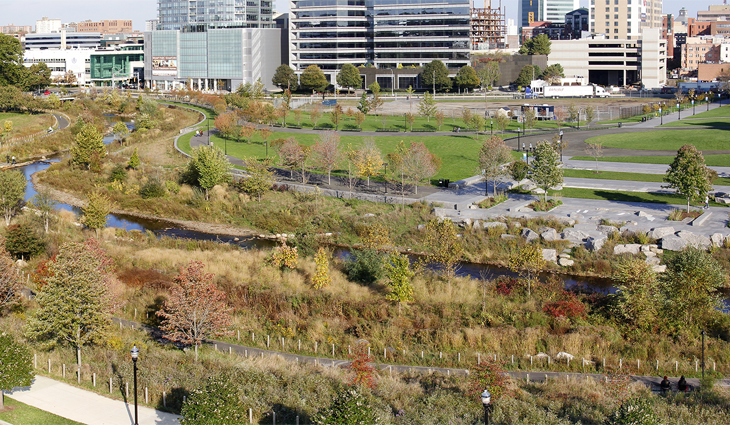ASLA's 125th: Connecticut Chapter – The Early Years
3/3/2024Leave a Comment

ASLA 2015 Professional General Design Honor Award. Mill River Park and Greenway. Stamford, CT. OLIN / Sahar Coston-Hardy
ByJeff Mills, Affil. ASLA
The Connecticut Chapter of ASLA (CTASLA) was formed in February 1948 by nine founding members. At the time, there were approximately 500 ASLA members nationwide. The Connecticut Chapter, which also included Rhode Island residents, became the 9th chapter of ASLA.
One of those charter members was George A. Yarwood, born in 1903 and an early practitioner of landscape architecture in Connecticut (License #02). His notable projects include work at Trinity College, United Technologies, the U.S. Coast Guard Academy, and the town plan for Mansfield, CT, where the University of Connecticut campus is located.
George Yarwood would leave an imprint on the profession in Connecticut for many years, serving as the first elected CTASLA president (1952-54), Trustee (1956-1957), and a member of the first State Board of Landscape Architects (1967-1972). He was elected an ASLA Fellow in 1964 and received the ASLA Presidents Award in 1980.
When he died in 1987, the chapter created the George A. Yarwood Award, still given annually today, to recognize members who have "given unselfishly of their time and talent to further the profession of landscape architecture within the state and the nation."
 Connecticut ASLA members at 1965 Annual Meeting, Hartford, CT.
Connecticut ASLA members at 1965 Annual Meeting, Hartford, CT.
CTASLA was born during the pent-up demand of the post-war years. That demand led to expansion of the landscape architecture profession. With California pointing the way in 1954 with registration of the title “landscape architect,” CTASLA began a multi-year campaign to establish licensure in the state.
In a memo to members early in 1955, Yarwood writes, "We are asking for passage of this bill because we believe our work is in the interest of public health, safety and welfare in that it involves all of these things when we plan housing developments, lay out subdivisions, plan school grounds, parks and recreation areas, industrial sites, as well as private grounds. The bill...simply requires that in the public interest only those qualified by training and experience can use the term 'Landscape Architect.'"
The 1955 campaign does not succeed. For various reasons, mainly political, it takes another dozen years and several more attempts at a bill before licensure is adopted by the Connecticut legislature in 1967 — another era of great expansion, with the Johnson Administration focused on urban renewal and beautification projects.
Thayer Chase — designer of the 38-mile-long Merritt Parkway, added to the National Register of Historic Places in 1991 — was president that year. In his testimony on the bill he says, "Never before in the history of the country has governmental support been so strong for the creative development of our natural and man-made landscape." What goes around...

April 1965 LAM Cover showing Constitution Plaza, Hartford, CT.
Also, ASLA's 65th Annual Meeting helped build momentum for licensure was ASLA's 65th Annual Meeting. The meeting was held in Hartford in June of 1965 — the one and only time the event has been held in Connecticut.
The report of the Secretary-Treasurer, dated December 31, 1965, and signed by George Yarwood, notes:
1965 was a memorable year for the Connecticut Chapter because for the first time the Chapter was host to the entire Society June 28-30 at the Statler-HiIton Hotel in Hartford. With official registration of 477, and a known attendance of over 500, this was at least one of the best attended Annual Meetings of the Society on record. The host chapter earned 60% of the registration fees amounting to $2,280.30, the largest amount of any annual meeting.
With the theme "Space for Survival," the meeting focused on the Great Society redevelopment programs. Walking tours of Constitution Plaza, designed by Sasaki, and other downtown sites were featured prominently.
CTASLA hosted an exhibit on Frederick Law Olmsted to acquaint visitors with the history and context of how Connecticut played an important role in his career.
Though we share him with the rest of ASLA and the world, CTASLA take great pride in Olmsted's Connecticut heritage. He was born and raised in Hartford and is interred in the city's Old North Cemetery. The hills and streams of the Connecticut landscape are where those first seeds that would inform his life's work were planted.
CTASLA marked its 75th anniversary in 2023. Nearly half those years ago, in 1987, Rhode Island practitioners split off to form an independent RIASLA.
Jeff Mills, Affil. ASLA, is executive director of the Connecticut Chapter of ASLA.


.png)
.png)
.png)
.png)
.png)
(1).png)

